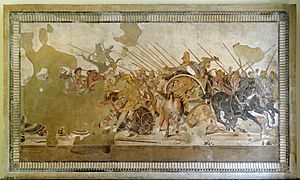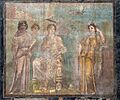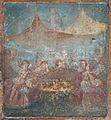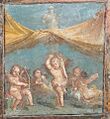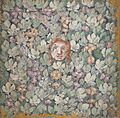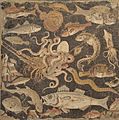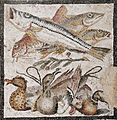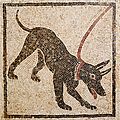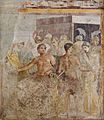National Archaeological Museum, Naples facts for kids
| Museo Archeologico Nazionale di Napoli | |
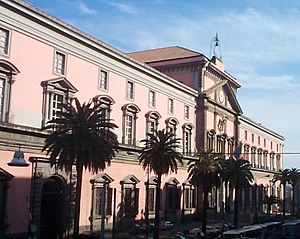
Façade of the museum
|
|
| Established | 1777 |
|---|---|
| Location | Piazza Museo 19, Naples, Italy |
| Type | archaeology |
| Collections | Roman, Greek, Egyptian |
| Visitors | 500.000 (2017) |
| Public transit access | Fermata Museo (Metropolitana linea 1) Fermata Piazza Cavour (Metropolitana linea 2) |
The National Archaeological Museum of Naples (also known as MANN) is a super important museum in Italy. It holds amazing treasures from Greek, Roman, and Renaissance times. You can see many Roman artifacts that were found in nearby ancient cities like Pompeii, Stabiae, and Herculaneum. These cities were buried by the eruption of Mount Vesuvius long ago. For a while, from 1816 to 1861, it was called the Royal Bourbon Museum.
Contents
The Museum Building
The building where the museum is located has a long history! It was first built in 1585 to be a place for cavalry soldiers. Later, from 1616 to 1777, it became the home of the University of Naples. In the 1800s, when it was turned into a museum, many changes were made to its main structure.
Amazing Collections
The museum has huge collections of ancient Greek and Roman items. Many of these come from the Farnese Collection. This collection includes beautiful engraved gems, like the famous Farnese Cup. This cup is a special bowl made from a stone called sardonyx agate. It was collected by important people like Cosimo de' Medici and Lorenzo il Magnifico way back in the 1400s. The museum also has the Herculaneum papyri, which are ancient scrolls that were burned and preserved by the Mount Vesuvius eruption.
Famous Marbles
Most of the museum's classical sculptures are from the Farnese Marbles. These are very important because they are Roman copies of ancient Greek statues. Often, these copies are the only way we know what the lost works of famous Greek sculptors looked like. Some of the biggest statues have been moved to the Museo di Capodimonte for display.
Here are some of the most famous marble sculptures:
- The Farnese Hercules: This huge statue helped shape how people in Europe imagined the hero Hercules.
- The Farnese Atlas: This is the oldest known statue of Atlas from Greek myths. It also shows the oldest view of the Western constellations, possibly based on an ancient star catalog.
- The Farnese Bull: Many people believe this is the largest single sculpture ever found from ancient times.
- The group Harmodius and Aristogeiton: This is a Roman copy of a bronze statue that once stood in the Agora in Athens.
- The Aphrodite Kallipygos statue.
- The Farnese Artemis: Another Roman copy of an original Greek artwork.
- A collection of busts, which are sculptures of the heads and shoulders of Roman emperors.
- Other Roman sculptures, mostly copies of Greek art, that once stood in the Baths of Caracalla in Rome.
Bronzes from the Villa of the Papyri
The museum also has a fantastic collection of ancient Roman bronze statues. These were found in the Villa of the Papyri. Some highlights include the Seated Hermes, a lively Drunken Satyr, and a bust of Thespis. There are also two very energetic statues of runners.

Amazing Mosaics
The museum's Mosaic Collection features many important mosaics. These were found in the ruins of Pompeii and other cities buried by Vesuvius. One of the most famous is the Alexander Mosaic, made around 100 BC. It was originally from the House of the Faun in Pompeii. This mosaic shows a big battle between the armies of Alexander the Great and Darius III of Persia. Another mosaic shows a gladiatorial fighter.
Beautiful Frescoes
The museum has a large collection of frescoes. These are wall paintings that were carefully removed from Pompeii and Herculaneum. They show us what ancient Roman homes looked like.
Ancient Egyptian Collection
With 2,500 objects, this museum has one of the biggest collections of Egyptian artifacts in Italy. Only museums in Turin, Florence, and Bologna have more. The collection mostly comes from two private collections. These were put together by Cardinal Stefano Borgia in the late 1700s and Picchianti in the early 1800s. You can see items from the Old Kingdom (around 2700-2200 B.C.) all the way up to the Roman era in Egypt.
The Special Collection
The museum has a special section that was once called the Secret Cabinet. The old Bourbon rulers of Naples created these private rooms. They kept a collection of unique artifacts, mostly found during excavations in Pompeii and Herculaneum. For a long time, only certain adults were allowed to see these items.
After a big change in government in 1848, some even suggested destroying the collection. They worried about what people might think. Instead, the museum director decided to make it even more private. The entrance was sealed with three different locks, and only a few people had the keys. In 1851, even statues of Venus were locked away, and the entrance was walled up!
When Garibaldi's forces took over Naples in 1860, he ordered the collection to be opened to the public. However, rules about who could see it and censorship continued for many years. During the Fascist period, you needed special permission from a government minister to visit. These rules slowly changed, and the collection was finally opened to everyone in April 2000. Today, visitors under 14 years old can only see the exhibit if they are with an adult.
Gallery
-
The Menologium Rusticum Colotianum, an ancient Roman almanac
See also
 In Spanish: Museo Arqueológico Nacional de Nápoles para niños
In Spanish: Museo Arqueológico Nacional de Nápoles para niños


